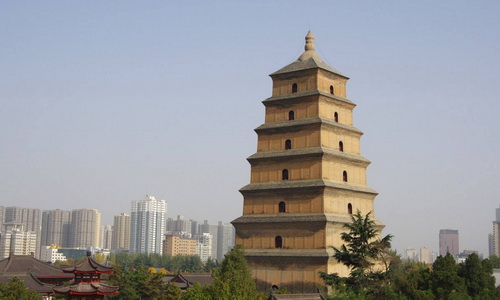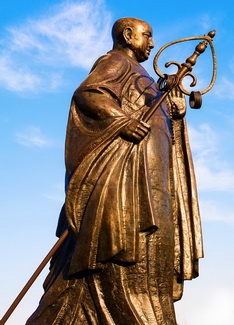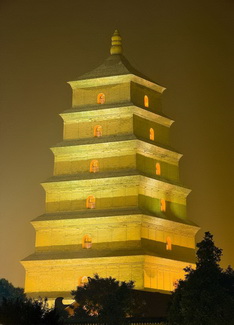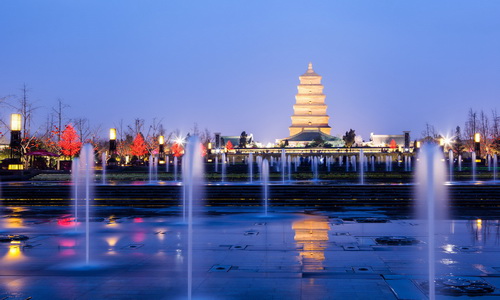Big Wild Goose Pagoda
Xi'an, one of the most ancient cities in the world, is always a prime destination for tourists. As a UNESCO World Heritage site and the landmark of this beautiful city, Big Wild Goose Pagoda (also known as Giant Goose Pagoda), has been a must-see place when you are traveling in China

Situated in Daci'en (great mercy and kindness) Temple complex in the southern suburb of Xi'an city, Big Wild Goose Pagoda is a well-preserved brick tower in Tang Dynasty and a symbol of the temple. Daci'en temple was first constructed in 648 by Prince Lizhi, the later Emperor Gaozong of Tang, who issued the decree building the temple in commemoration of his mother Empress Zhangsun. Xuanzang (602-664), a renowned Buddhist monk, was the first abbot of the temple. During his tenure, he managed the construction of Big Wild Goose Pagoda.
Holding a large amount of Buddhist relics, sutras and figures of Buddha brought back to China from India by Xuanzang, as well as other relative cultural relics, Big Wild Goose Pagoda is a great museum of Buddhist art and culture.

Starting off from Chang'an (the ancient Xian), Xuanzang travelled along the Silk Road to Tianzhu (currently India) in the seventh century after overcoming countless difficulties and obstacles during his seventeen years of overland journey. According to his biography, he returned with over six hundred Mahayana and Hinayana texts, seven statues of the Buddha and more than a hundred sarica relics. For storage of those precious sutras and figurines of Buddha, Xuanzang designed and supervised the building of Big Wild Goose Pagoda. Later, he invited around 50 hierarchs into Ci'en temple to translate Sanskrit sutras into Chinese. His translation, still stored in Big Wild Goose Pagoda today, opened a new era in the history of translation and Buddhism in China.
In celebration of Xuanzang's extraordinary contribution in translating the Buddhist texts, emperor Gaozong of Tang ordered renowned Tang calligrapher Chu Suiliang and inscriber Wan Wenshao to install two stele stones, collectively known as the Emperor Preface to the Sacred Teachings, at the Big Wild Goose Pagoda, which could be found on the walls beside the doors of the ground floor now. And visitors can also appreciate the statues of Buddha engraved on the interior walls of the pagoda by renowned artist Yan Liben.
So, Big Wild Goose Pagoda is not only a tourist attraction but also a great museum and an important historic heritage to China and the world. On June 22, 2014, Big Wild Goose Pagoda was added to the World Heritage list.

As for its name, legend has it that the building gets its name from a Buddhist story. Many years ago, one of the two Buddhist branches were not forbidden to eat meat. One day, a monk was starving and had no meat for meal. Seeing a flock of wild geese flying over the sky, he prayed, I wish I could have some meat to eat. At that very moment, the leading wild goose broke its wings and dropped right in front of him. All his fellow monks were shocked and believed that Bodhisattva showed his spirit and blamed them for their mercilessness. So they built a pagoda on the place where the goose fell, named it 'Wild Goose Pagoda', and stopped eating meat since then. Xuanzang visited this Pagoda during his trip in India and was inspired and moved. When he designed the pagoda in Ci'en temple, he gave the pagoda the same name to show his respect as well as to inspire more people.
Besides its profound history and culture significance, this pagoda is also a constructional marvel in Buddhist history. Due to ground subsidence caused by over-pumping of underground water, Big Wild Goose Pagoda leans very perceptibly several degrees to the west for which reason also being called the 'Oriental Torre di Pisa. Currently standing at a height of 64 meters (210 feet), this 7-storey leaning pagoda was originally built in 652 A.D. to a height of 60 meters (197 feet) with 5 stories. The original structure was a construction of rammed earth with a stone facade that was collapsed five decades later. Empress Wu Zetian rebuilt the pagoda and added five new stories by the year 704.

In 1556, a massive earthquake heavily damaged the pagoda and reduced it by three stories, to its current height of seven stories. It was extensively repaired during the Ming dynasty (1368-1644) and renovated again in 1964, which has been well-preserved until today. Built of brick, this pagoda externally looks like a square cone firmly standing on its base, simple but grand. Winding stairs go up inside the pagoda so that visitors can climb and have an overview of Xi'an city. As an honor of citizens in this Xi'an city, Big Wild Goose Pagoda still endowed with outstanding beauty and grace after more than a thousand years of winds and rains.
Today, Big Wild Goose Pagoda is like a beautiful pearl on the crown of this fabulous city. It is also like a time-machine driving people back to Tang Dynasty in a blink of eye.
50 RMB for the entrance of the Da Ci'en Temple
30 RMB for ascending the Big Wild Goose Pagoda
Transportation:Bus No. 5, 21, 23, 27, 30, 41, 224, 320, 401, 500, 501, 527, 601, 606, 609 and 715 will take you here.
You can also take subway line 3 to Dayanta Station or line 2 to Xiaozhai Station (Exit C) and walk eastward for 10 minutes.









